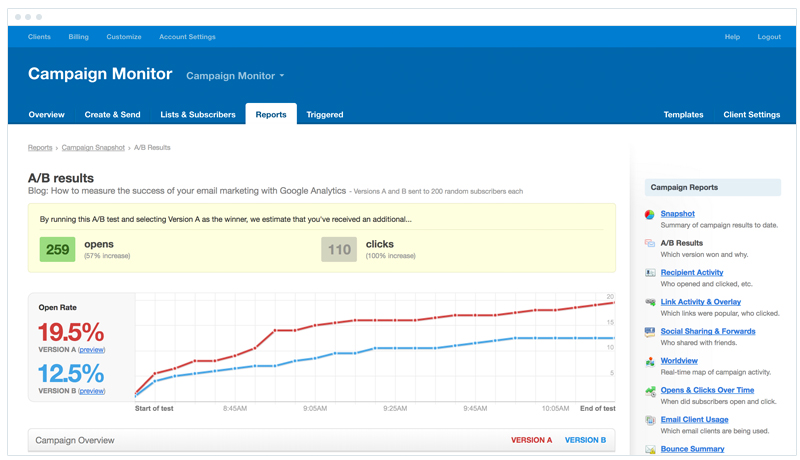
I have to hand it to the guys at Buffer, the recommended content section was a genius play. Not only did they create a feature that has probably tripled product usage, but they created a content distribution channel that they can use to send content on a sharing rampage.
I’d heard through a content marketing friend of mine that getting featured in their recommended section drives a ton of social sharing activity, and I was definitely intrigued by the idea.
That said, the recommended section is human curated and Courtney, Kevan and the guys over at Buffer know content well, so getting featured wasn’t going to be some little hack or trick you could pull.
So how did we do it? And what were the results? Read on to find out.
How one of our articles ended up in Buffer’s recommended content section
I had always been inspired by Buffer’s idea of A/B testing blog headlines against each other using Tweets, and then changing the headline of the post based on which tweet performed better.
However, when I started running content over at Campaign Monitor (an email marketing tool), I realised there was an even better way to do this – A/B testing blog headlines using email subject lines.
So we started doing it on our blog subscribers email which goes out to a few thousands subscribers each time we publish a post, and we started getting some GREAT results from it.
In fact, in one post on measuring your email marketing using Google Analytics we got a 57% increase in opens on line A over line B.

This is a huge result, and likely netted us a few thousand more visitors from social networks as the improved headline results in more click-throughs when readers share the post via their Twitter & Facebook accounts.
Being an email marketing blog, we decided to share our little trick with the world and wrote up a step by step guide to how to do it. Given that the idea was inspired by the Buffer guys anyway, I decided to mention them in the post and actually challenged them somewhat, outlining why I thought using email subject lines was a more accurate way of testing blog post headlines than using tweets.
When the post was published I reached out to Kevan via Twitter and let him know it was around. I have had a few tweet exchanges with Kevan in the past but we are certainly far from besties, so I tried to engage him by asking for his thoughts on our approach.
I never actually heard back from him, but I did notice a click-through from that tweet was recorded so I was hopeful he had at least checked out the post.
What really happens when your content gets featured
Turns out Kevan did check it out and obviously liked it, because when I woke up on Saturday morning I had a whole heap of notifications on Twitter and sure enough, there were 100’s of tweets of the post coming through.
I checked the Buffer and Daily apps on my phone, and sure enough there was our post in the Recommended Content section.

I’m not going to lie, it was really exciting. I’d check my phone every hour or so and there’d be a hundred or so new shares of the post.
It was very ego-boosting and I was really excited to check out our analytics a few days later to analyse see the traffic data and analyse the flow on effect into subscribers, signups and customers. We’d recently had another post go quite well on social media and it had driven a bunch of traffic, so I was looking forward to seeing a similar result.
To my surprise, despite the huge number of shares (over 800 at last count, a good 10 – 15x more than our average per post), there was no visible spike in traffic and certainly no positive effect on any of the main KPI’s like subscribers, signups & customers.
Keen to understand a bit more about this, I started looking through the tweets and noticed some interesting patterns.
- The type of people who were sharing them was really random – Of the 800 or so shares we had, there was no real discernible pattern between the people who shared the piece. There were mechanics, personal trainers and even a priest amongst the people who shared the content. Considering this is a very niche post that would likely only appear to content marketers, it was odd to see people who probably don’t even know what A/B testing is sharing the post.
- The people who shared it didn’t actually appear to have even read the article – This is quite anecdotal evidence, but pretty much every tweet was the exact same text as Buffer had added to their recommendations section and it appeared people had just gone through and clicked ‘Share’ without actually reading the content. Perhaps it’s just my sharing habits, but when I share something on Twitter I usually add a personal comment like ‘Great read’ or ‘Cool idea for marketers’ and occasionally throw in a hashtag as well, but basically nobody had added any sort of commentary to the tweet or modified it in any way.
To dive deeper into this, I spent some time looking through the feeds of some of the people who had shared it and I found that majority of the accounts I looked at had shared a lot of content I’d seen in the recommended content section before.
Based on these patterns, my guess is that there are a lot of fake or inactive accounts that are just hooked up to automatically tweet out content from Buffer’s recommended section.
Given this kind of ‘automated’ sharing activity, it makes sense that their audience isn’t hugely engaged with their tweets and therefore aren’t clicking through to read the content they share.
What you can learn from this
If you’re looking for advice on how to get your content featured in Buffer’s recommended content section, you might be a little disappointed.
Kevan and Courtney are awesome content marketers and no amount of tricks or hacks will land you in there. So my advice is really simple:
- Write epic content that would appeal to them and their audience
- Make sure they know about it (by tweeting at them or I believe there is a form somewhere).
However if you think getting featured in the recommended section is going to be a silver bullet for your content then you’re going to be further disappointed. Perhaps it was just the particular niche of our content, but as I mentioned earlier there was almost no increase in traffic or any of the metrics that really matter.
This also speaks to a larger trend I’ve seen recently where the posts with the most sharing activity aren’t actually the ones with the most traffic. This is particularly true for Twitter and I can remember 2 or 3 times on the Campaign Monitor blog where an article has had a large amount of shares but no discernible increase in visits.
According to this Quora thread, the average CTR on a tweet is around 0.3% but I know personally my CTR is closer to 0.1%. I’ve also worked with few marketing influencers who have 100k+ followers but an individual tweet would be lucky to get 20-30 click-throughs.
This might be pretty good if you are just starting to build your following, but when your doing content marketing at scale unfortunately 20-30 clicks doesn’t move the needle much.


No Comments